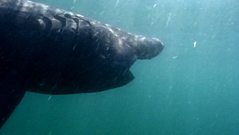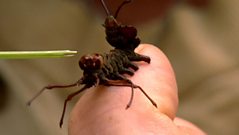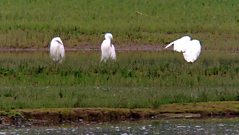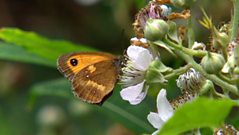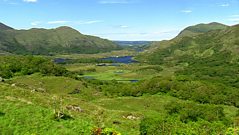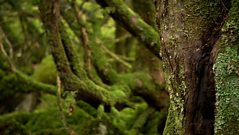
Sleepy and speedy
As a species, the dormouse is widespread across much of Europe. However, in parts of its northern range populations are in decline. Dormice are protected in the UK as they've been scarce since WWII owing to changes in farming practices, loss of hedgerows and the fragmentation of woodlands. In 2005, the total adult population was estimated to be around 45,000, distributed widely across the fragmented forests of England and Wales. Dormice are sensitive to changes in weather and climate and are particularly fussy eaters. As a result, they are vulnerable to local extinctions and are now the subject of a UK Biodiversity Action Plan aiming to restore their numbers.
In Cornwall, you don't have to go far from the coast to find some wonderful woodlands. Bill Oddie and Steve go in search of a creature that lives there - the dormouse. The name comes from the French 'dormir' which means 'to sleep', and boy do they sleep. They hibernate from October to May and even in summer they are only really active at night. They live way in in the tops of trees, so what chance do you have of seeing them? The answer is to provide custom-built sleeping quarters. The first few boxes that Bill and Steve look at are empty – and in the next the dormouse shoots off before the camera can catch it. But their luck is in - there are babies in the nest box. Steve takes one that's just a few days old out to show Bill. The breeding season is form May to August, and dormice can have two broods a year. There has been a very good crop of hazelnuts this year, so hopefully a large number of this year's young will hibernate successfully if they eat well and get up to the right weight. Weight is critical for hibernation - if they fail to make a certain weight they won't survive. They put the baby back in the nest before he gets chilled. Steve finds another nest box with an adult in it. You have to be registered as a dormouse handler to pick one up. Dormice have few predators because they stay up in the canopy. Owls will take one occasionally and weasels are a problem predating the boxes. Dormice are quite long lived - four or five years - which is quite long for a small mammal. It finds its food in the dark using smell, whiskers and the memory of what's available in their patch at different times of year. They eat caterpillars in the spring and are very fond of blackberries and hazelnuts. The dormouse escapes Steve's grasp and shoots off.
Duration:
This clip is from
Featured in...
![]()
Cute animal babies
Favourite video clips of the some of the worlds cutest animal babies.
![]()
91�ȱ� Nature
Be captivated, informed and inspired by the world's wildlife.
![]()
On the Brink
A collection of clips highlighting some of the most vulnerable animals and plants on Earth.
More clips from Cornwall
-
![]()
Cornish cream
Duration: 00:45
-
![]()
Lobster moth
Duration: 01:12
-
![]()
Here to stay
Duration: 02:24
-
![]()
Flutter by, butterfly
Duration: 03:20
More clips from Bill Oddie Goes Wild
-
![]()
Mossy woodland—Series 3, South West Ireland
Duration: 01:59
-
![]()
Chough country—Series 3, South West Ireland
Duration: 03:52
-
![]()
Deserted village—Series 3, South West Ireland
Duration: 01:36
-
![]()
Yew forest—Series 3, South West Ireland
Duration: 01:48


